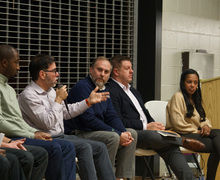SU professor joins national team researching infrastructure, extreme weather
A Syracuse University professor recently joined a complex international project that researches how to build infrastructure that can withstand extreme weather in urban areas such as the city of Syracuse.
The Urban Resilience to Extreme Weather-Related Events Sustainability Research Network (UREx SRN) is funded by the National Science Foundation. The team has $12 million to utilize for research over the next five years, according to an SU News Release.
“The mission of the whole team is to understand the way that urban society is impacted by extreme climate and to help understand the strategies that allows communities to be either responsive or resilient to the cascade impacts from extreme climate events,” said David Chandler, a professor on the team who teaches civil and environmental engineering in the College of Engineering and Computer Science.
Chandler said he has a particular interest in hydrology and has been researching the sustainable use of water and the effects of extreme precipitation in Syracuse prior to becoming involved with UREx SRN.
While Chandler said his knowledge of hydrology will be an asset to the team, this project is quite different than the work he’s done in the past.
“In my hydrology work in other projects I’m taking more of a deep dive on a specific question,” Chandler said. “In this project, a lot of the role of Syracuse University will be to develop, manage and visualize the data sets from across the network of sites. So we have a large task in terms of information management, synthesis and visualization.”
The research project spans across the Americas and has teams in Phoenix; Baltimore; Miami; New York City; Portland; Hermosillo, Mexico; San Juan, Puerto Rico; and Valdivia, Chile, according to the release.
Chandler said SU has collaborated with researchers at Arizona State University for quite a while, which is why they thought of SU when looking for people to join the project.
Syracuse, conveniently, was also a desirable target city because it is big enough to be viewed as an urban area, yet small enough that the data analysis won’t be impractical to do within the timeframe they have, Chandler said.
The team will be using a more holistic approach to tackle the problems brought on by extreme weather, according to an ASU press release. Its methods include recognizing the values of all stakeholders, such as city decision makers and the people who will use and be affected by infrastructure, understanding the natural environment in which infrastructure operates and evaluating available infrastructure technology, according to the release.
Chandler said before considering what infrastructure would be most effective, the team must consider what the weather will be like in the future and if infrastructure can offer multiple benefits to a city.
For example, he said the team could make an investment in changing infrastructure that benefits water conveyance that is underground, which would never be seen or utilized by the public. However, the team could solve some of the same problems using green space, such as parks, to limit runoff and utilize natural evaporation to make it cooler.
Chandler said questions relating to climate change are becoming more and more pressing. In response to these questions, he said the team’s overarching premise is to address the urban management of extreme events in light of antiquated infrastructure that cannot withstand extreme weather.
“Climate change is absolutely the question of the day,” Chandler said.
Published on October 19, 2015 at 8:13 pm
Contact BreeAnna: blposhek@syr.edu





